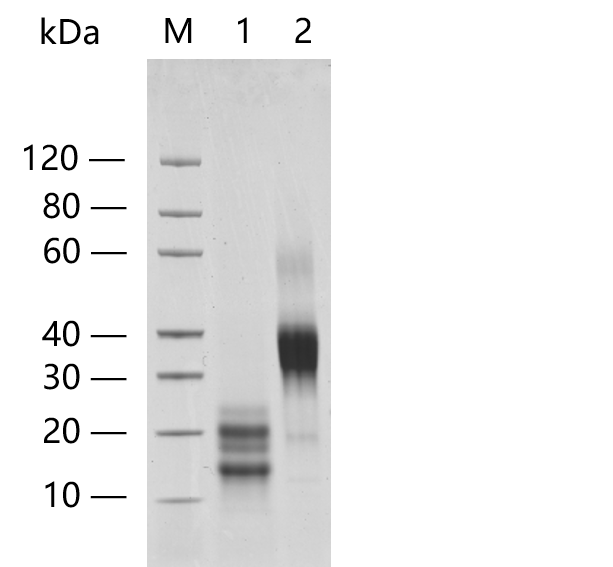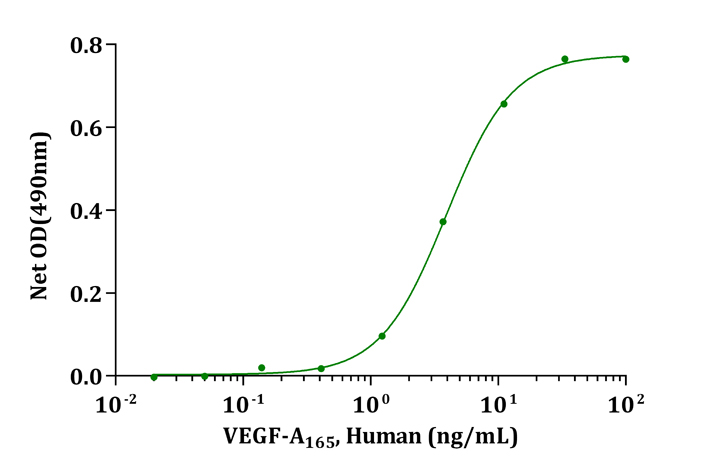VEGF165, Human
| ¥600 | |
| Z02689-10 | |
|
|
|
|
|
|
|
|
|
| ¥600 | |
| Z02689-10 | |
|
|
|
|
|
|
|
|
|
| Species | Human | |
| Protein Construction |
|
|
| Purity | > 95% as analyzed by SDS-PAGE | |
| Endotoxin Level | < 0.5 EU/μg of protein by gel clotting method | |
| Biological Activity | ED50 of 1.0-5.0 ng/ml, measured by the dose-dependent stimulation of the proliferation of HUVEC cells, corresponding to a specific activity of 2.0 × 105-1.0 × 106 U/mg. | |
| Expression System | P. pastoris | |
| Apparent Molecular Weight |
~ 38-40 kDa, on SDS-PAGE under non-reducing conditions ~ 18-20 kDa, on SDS-PAGE under reducing conditions Structure/form: Disulfide-linked homodimer |
|
| Formulation | Lyophilized after extensive dialysis against 25 mM HEPES, 150 mM NaCl, pH 7.0. | |
| Reconstitution | It is recommended that this vial be briefly centrifuged prior to opening to bring the contents to the bottom. Reconstitute the lyophilized powder in ddH₂O up to 100 μg/ml. | |
| Storage & Stability | Upon receiving, this product remains stable for 6 months at lower than -70°C. Upon reconstitution, the product should be stable for 1 week at 4°C or for 3 months at -20°C. For long term storage it is recommended that a carrier protein (example 0.1% BSA) be added. Avoid repeated freeze-thaw cycles. |

»

»

GenScript product showed better activity compared to competitor P »

GenScript product showed better activity compared to competitor S »

GenScript product showed better activity compared to competitor R »

Recombinant VEGF165, Human (Z02689) was resolved by SDS-PAGE stained with coomassie blue, under reducing (R) and non-reducing (N) conditions, showing major bands at ~ 18-20 kDa and ~ 38-40 kDa, respectively. Multiple bands or smear in the gel are caused by glycosylation.
Lane 1: 2 µg of Z02689, reducing (R)
Lane 2: 2 µg of Z02689, non-reducing (N)
> 95% as analyzed by SDS-PAGE »

Biological Activity
VEGF-A165, Human (Cat. No. Z02689) stimulates cell proliferation of HUVEC cells. The ED50 for this effect is typically 1-5 ng/mL. »
| Target Background | Vascular Endothelial Growth Factor (VEGF) is a potent growth and angiogenic cytokine. It stimulates proliferation and survival of endothelial cells, and promotes angiogenesis and vascular permeability. Expressed in vascularized tissues, Vascular Endothelial Growth Factor (VEGF) plays a prominent role in normal and pathological angiogenesis. Substantial evidence implicates Vascular Endothelial Growth Factor (VEGF) in the induction of tumor metastasis and intra-ocular neovascular syndromes. Vascular Endothelial Growth Factor (VEGF) signals through the three receptors; fms-like tyrosine kinase (flt-1), KDR gene product (the murine homolog of KDR is the flk-1 gene product) and the flt4 gene product. |
| Synonyms | VEGF-165; Vascular Endothelial Growth Factor 165; VPF; Folliculostellate cell-derived growth factor; Glioma-derived endothelial cell mitogen; Vascular Permeability Factor |
For laboratory research use only. Direct human use, including taking orally and injection and clinical use are forbidden.